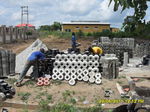ETERNALSTONE NIGERIA ENTERPRISES
Use of Paving Stones in History
Interlocking Paving Stones have been around for over 5,000 years. The first roads around 3,000 BC were made from segmental paving units on the isle of Crete. The Romans, more than 2,000 years ago, used tightly fitted cut stones set on a compacted aggregate base to create a superior roads. Today, tourists still walk those same roads over the original paving stones. They are simple, economical, durable, flexible, and virtually maintenance-free, the Roman system became the concept for a most versatile PAVING SOLUTION. The use and popularity of Interlocking Paving Stones is growing by leaps and bounds in the world today.
The modern paving stone system uses precision manufactured concrete interlocking paving stones. Developed in the Netherlands shortly after World War II as a replacement for clay brick streets, concrete pavers became the norm in Europe. The value of interlocking concrete pavements has certainly been proven worldwide, and is rapidly expanding its recognition and momentum as an ideal pavement in Nigeria. Interlocking Paving Stones are made from either CONCRETE (The best method) or clay. They are set in sand rather than mortar and out perform mortar set stones and brick in durability, strength and flexibility(the ability to resist cracking). Segmented pavements are stronger than brick; Are eartquake resistant; FLEXIBLE - they can expand and contract without cracking; STRONG AND DENSE - they have the durability to withstand all climatic conditions; PRACTICAL - they can accomodate any type of traffic without cracking under heavy loads; PLOW SAFE - shovels, and other conventional plowing equipments pose no problem for properly installed pavers; VERSATILE - they can be used for walks, patios, pool decks, driveways, streets... even heavy-duty industrial projects! EASY TO MAINTAIN - They are unaffected by oil and gas spills. When repairs are necessary, they can be lifted and reinstated without leaving an unsightly permanent "patch" as with other paving solution. E.g. concrete.
The modern paving stone system uses precision manufactured concrete interlocking paving stones. Developed in the Netherlands shortly after World War II as a replacement for clay brick streets, concrete pavers became the norm in Europe. The value of interlocking concrete pavements has certainly been proven worldwide, and is rapidly expanding its recognition and momentum as an ideal pavement in Nigeria. Interlocking Paving Stones are made from either CONCRETE (The best method) or clay. They are set in sand rather than mortar and out perform mortar set stones and brick in durability, strength and flexibility(the ability to resist cracking). Segmented pavements are stronger than brick; Are eartquake resistant; FLEXIBLE - they can expand and contract without cracking; STRONG AND DENSE - they have the durability to withstand all climatic conditions; PRACTICAL - they can accomodate any type of traffic without cracking under heavy loads; PLOW SAFE - shovels, and other conventional plowing equipments pose no problem for properly installed pavers; VERSATILE - they can be used for walks, patios, pool decks, driveways, streets... even heavy-duty industrial projects! EASY TO MAINTAIN - They are unaffected by oil and gas spills. When repairs are necessary, they can be lifted and reinstated without leaving an unsightly permanent "patch" as with other paving solution. E.g. concrete.
Sizes and Shapes
Interlocking Concrete Paving Stones are mainly of 3 sizes as listed below;
1. 40mm thick pavers are only used to pave walkways but they are not commonly found.
2. 60mm thick pavers are commonly used for pedestrian areas, driveways, and other areas subject to limited vehicular use.
3. 80mm thick pavers are importantly needed for streets and industrial areas expected to carry heavy duty machines and vehicles. e.g. Airport and Seaports.
While in terms of shape, Interlocking Concrete Paving Stones features a wide range of shapes, colours and styles.
Why The Best?
An important study in Japan demonstrate the ability of interlocking concrete pavements to reduce accidents and increase safety at intersections. Accidents were monitored over 12months and vehicle braking distances were measured with a high speed video camera at an asphalt-paved intersection in Ichihara City. Daily traffic volumes on each street from 7.00am - 7.00pm ranged between 3,479 and 7,119 vehicles. After 6months of monitoring traffic volumes and accidents, the asphalt within and on the approaches to the intersection was removed and replaced with concrete pavers. The change in pavement surface reduced the number of accidents by nine from December to May compared accidents counted in the previous June - November period. The concrete pavers also reduced braking distances. A light - duty van was tested with three drivers on wet and dry conditions stopping from 20, 40, and 60 kph. Stopping distances were shorter on the concrete pavers and the greatest improvement was a reduction of 5m(16ft) at 60 kph. The contribution of the chamfers in the surface of the concrete pavers towards dispersing water may explain the reduction in stopping distances at this speed.
